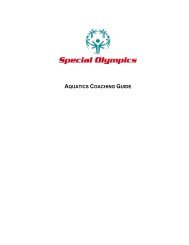Bocce Coaching Guide - Special Olympics
Bocce Coaching Guide - Special Olympics
Bocce Coaching Guide - Special Olympics
You also want an ePaper? Increase the reach of your titles
YUMPU automatically turns print PDFs into web optimized ePapers that Google loves.
Tips for Conducting Safe Training Sessions<br />
14<br />
<strong>Bocce</strong> <strong>Coaching</strong> <strong>Guide</strong><br />
Planning a <strong>Bocce</strong> Training & Competition Season<br />
Though the risks can be few, coaches have a responsibility to ensure that athletes know, understand and appreciate the<br />
risks of bocce. The safety and well-being of athletes are the coaches primary concerns. <strong>Bocce</strong> is not a dangerous sport,<br />
but accidents do occur when coaches forget to take safety precautions. It is the head coach s responsibility to minimize<br />
the occurrence of injuries by providing safe conditions.<br />
1. Establish clear rules for behavior at your first practice and enforce them.<br />
2. When the weather is poor, have a plan to immediately remove athletes from inclement weather.<br />
3. Make sure athletes bring water to every practice, especially in hotter climates.<br />
4. Check your first aid kit; restock supplies as necessary.<br />
5. Train all athletes and coaches on emergency procedures.<br />
6. Choose a safe field area. Do not practice in areas with rocks or holes that could cause injury. Simply telling<br />
players to avoid obstacles is not enough.<br />
7. Walk the court and remove unsafe objects. Be particularly vigilant when you are playing in cluttered indoor<br />
gyms. Remove anything that a player might run into.<br />
8. Check the bocce balls for cracks that could chip or split. Balls and may cause eye injury.<br />
9. Check that the side and end walls are secured in the ground. Instruct players never to walk along the top of the<br />
court s walls. Pay particular attention to portable courts that tip over in a high wind or if players stand on them<br />
or a bocce ball rebounds off them. Make sure these walls are securely staked into the ground.<br />
10. Review your first-aid and emergency procedures. Have someone who is trained in first-aid and CPR on or very<br />
near to the court during practice and games.<br />
11. Ensure that athlete emergency contact details are up to date and close at hand during practices and games.<br />
12. Warm-up/cool-down and stretch properly at the beginning/end of each practice to prevent muscle injuries.<br />
13. Train to improve the general fitness level of your players. Physically fit players are less likely to get injured.<br />
Make your practices active.<br />
14. Make sure that players are physically matched in games where players go against each other head-to-head<br />
(e.g. one-on-one drills).<br />
15. Require all your players to wear appropriate attire, especially footwear, at practices and games.<br />
16. Do not use yourself as a target, i.e. stand in front of athletes and instruct them to throw/roll the ball to you or<br />
your feet.<br />
17. Ensure that you have easy access to a telephone or mobile phone.<br />
18. When not in use, bocce balls should always remain on the ground, not tossed in the air or bounced in the hand.<br />
It should be remembered that bocce balls are heavy and may break, or otherwise injure, a toe or foot if<br />
dropped.<br />
19. To avoid competitors slipping on bocce balls, balls should be placed in the rear corner of the court when not<br />
being used. Never leave bocce balls lying around the courts or training area where someone may stand on or<br />
trip over them.<br />
<strong>Special</strong> <strong>Olympics</strong> <strong>Bocce</strong> <strong>Coaching</strong> <strong>Guide</strong>- December 2005

















